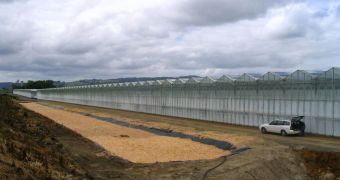Nitrogen is one of the most important chemicals on our planet, providing for example the backbone of our atmosphere. But it can be a real burden to take it out of the environment when excess concentrations develop, and this is why experts are always looking for new technologies to do so.
This substance can be found in abundance in fertilizers and other chemicals used for agriculture. Runoffs from crop fields collect nitrogen from the plants, and then carry it away.
It eventually leads in groundwater, contaminating wells and other freshwater supplies, but it can also go into lakes, streams, rivers, estuaries, deltas and the ocean.
Once this happens, the chemical begins to promote the development of algal blooms, which love nitrogen, but consume vast amounts of water-bound oxygen to develop.
As this happens, more and more species in that area begin to suffocate, and they either die off, or they swim away. This is how an oceanic dead zone is formed, experts say.
Agricultural and urban lands are the main sources of nitrogen today, and scientists have been working on methods of reducing their impact on the environment for many years, experts at the US National Science Foundation (NSF).
What researchers were looking for was a cost-effective method of eliminating the chemical from drain water, and agricultural and urban runoffs before these gray waters made their ways into sensitive ecosystems, or underground.
The goal for such technologies has remained elusive for now, but that's about to chance soon, according to participants at a denitrification workshop. The meeting united ecologists, engineers and policy experts in a single room, to try and find solutions to the nitrogen problem.
The NSF Denitrification Research Coordination Network (RCN) sponsored the workshop, which was held in May 2009 at the University of Rhode Islands. Details of the techniques discussed there will appear in a special November issue of the scientific journal Ecological Engineering.
“This special issue of Ecological Engineering, with its focus on managing denitrification in human-dominated landscapes, highlights our need to understand Earth's microorganisms and their processes,” explains the program director of the NSF Division of Environmental Biology, Matt Kane.
“The RCN brought together an international and interdisciplinary group of scientists and engineers to synthesize the knowledge necessary to provide pure water for generations to come,” he adds.
“Research presented in this special issue of Ecological Engineering goes a long way toward applying a scientific understanding of the biological processes of denitrification to the engineering challenges of denitrifying bioreactors,” explains Eric Davidson.
The scientist holds an appointment at the Woods Hole Research Center, in Falmouth, Massachusetts.
“The resulting guidelines and principles for denitrifying bioreactor design and operation are an additional option in the land manager's tool box,” he concludes.

 14 DAY TRIAL //
14 DAY TRIAL //